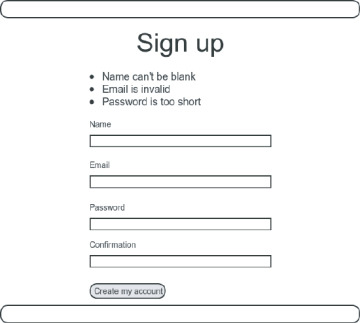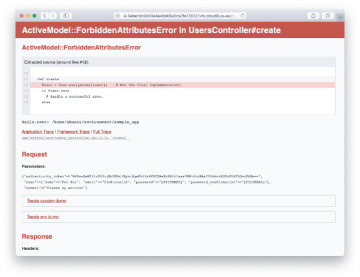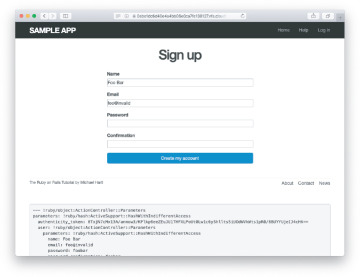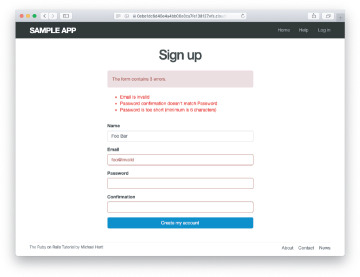- 7.1 Showing Users
- 7.2 Signup Form
- 7.3 Unsuccessful Signups
- 7.4 Successful Signups
- 7.5 Professional-Grade Deployment
- 7.6 Conclusion
7.3 Unsuccessful Signups
Although we’ve briefly examined the HTML for the form in Figure 7.14 (shown in Listing 7.17), we haven’t yet covered any details, and the form is best understood in the context of signup failure. In this section, we’ll create a signup form that accepts an invalid submission and re-renders the signup page with a list of errors, as mocked up in Figure 7.16.

Figure 7.16: A mockup of the signup failure page.
7.3.1 A Working Form
Recall from Section 7.1.2 that adding resources :users to the routes.rb file (Listing 7.3) automatically ensures that our Rails application responds to the RESTful URLs from Table 7.1. In particular, it ensures that a POST request to /users is handled by the create action. Our strategy for the create action is to use the form submission to make a new user object using User.new, try (and fail) to save that user, and then render the signup page for possible resubmission. Let’s get started by reviewing the code for the signup form:
<form action="/users" class="new_user" id="new_user" method="post">
As noted in Section 7.2.2, this HTML issues a POST request to the /users URL.
Our first step toward a working signup form is adding the code in Listing 7.18. This listing includes a second use of the render method, which we first saw in the context of partials (Section 5.1.3); as you can see, render works in controller actions as well. Note that we’ve taken this opportunity to introduce an if–else branching structure, which allows us to handle the cases of failure and success separately based on the value of @user.save, which (as we saw in Section 6.1.3) is either true or false depending on whether or not the save succeeds.
Listing 7.18: A create action that can handle signup failure.
app/controllers/users_controller.rb
class UsersController < ApplicationController
def show
@user = User.find(params[:id])
end
def new
@user = User.new
end
def create
@user = User.new(params[:user]) # Not the final implementation!
if @user.save
# Handle a successful save.
else
render 'new', status: :unprocessable_entity
end
end
end
Note the comment: This is not the final implementation. But it’s enough to get us started, and we’ll finish the implementation in Section 7.3.2. Also note the use of status: :unprocessable_entity (corresponding to the HTTP status code 422 Unprocessable Entity), which is necessary to render regular HTML when using Turbo (which we’ll install in Section 8.2.4 and cover in more depth in Section 14.2.5). The form will work anyway as long as you included --skip-bundle as in Listing 3.1, but it would fail in Section 8.2.4 after installing Turbo, and it does no harm to include it now.12
The best way to understand how the code in Listing 7.18 works is to submit the form with some invalid signup data. The result appears in Figure 7.17, and the full debug information appears in Figure 7.18.

Figure 7.17: Signup failure upon submitting invalid data.

Figure 7.18: Signup failure debug information.
To get a better picture of how Rails handles the submission, let’s take a closer look at the user part of the parameters hash from the debug information (Figure 7.18):
"user" => { "name" => "Foo Bar",
"email" => "foo@invalid",
"password" => "[FILTERED]",
"password_confirmation" => "[FILTERED]"
}
This hash gets passed to the Users controller as part of params, and we saw starting in Section 7.1.2 that the params hash contains information about each request. In the case of a URL like /users/1, the value of params[:id] is the id of the corresponding user (1 in this example). In the case of posting to the signup form, params instead contains a hash of hashes, a construction we first saw in Section 4.3.3, which introduced the strategically named params variable in a console session. The debug information above shows that submitting the form results in a user hash with attributes corresponding to the submitted values, where the keys come from the name attributes of the input tags seen in Listing 7.17. For example, the value of
<input id="user_email" name="user[email]" type="email" />
with name "user[email]" is precisely the email attribute of the user hash.
Although the hash keys appear as strings in the debug output, we can access them in the Users controller as symbols, so that params[:user] is the hash of user attributes—in fact, exactly the attributes needed as an argument to User.new, as first seen in Section 4.4.5 and appearing in Listing 7.18. This means that the line
@user = User.new(params[:user])
is mostly equivalent to
@user = User.new(name: "Foo Bar", email: "foo@invalid",
password: "foo", password_confirmation: "bar")
In previous versions of Rails, using
@user = User.new(params[:user])
actually worked, but it was insecure by default and required a careful and error-prone procedure to prevent malicious users from potentially modifying the application database. In Rails versions later than 4.0, this code raises an error (as seen in Figure 7.17 and Figure 7.18), which means it is secure by default.
7.3.2 Strong Parameters
We mentioned briefly in Section 4.4.5 the idea of mass assignment, which involves initializing a Ruby variable using a hash of values, as in
@user = User.new(params[:user]) # Not the final implementation!
The comment included in Listing 7.18 and reproduced above indicates that this is not the final implementation. The reason is that initializing the entire params hash is extremely dangerous—it arranges to pass to User.new all data submitted by a user. In particular, suppose that, in addition to the current attributes, the User model included an admin attribute used to identify administrative users of the site. (We will implement just such an attribute in Section 10.4.1.) The way to set such an attribute to true is to pass the value admin='1' as part of params[:user], a task that is easy to accomplish using a command-line HTTP client such as curl. The result would be that, by passing in the entire params hash to User.new, we would allow any user of the site to gain administrative access by including admin='1' in the web request.
Previous versions of Rails used a method called attr_accessible in the model layer to solve this problem, and you may still see that method in legacy Rails applications, but as of Rails 4.0 the preferred technique is to use so-called strong parameters in the controller layer. This allows us to specify which parameters are required and which ones are permitted. In addition, passing in a raw params hash as above will cause an error to be raised, so that Rails applications are now immune to mass assignment vulnerabilities by default.
In the present instance, we want to require the params hash to have a :user attribute, and we want to permit the name, email, password, and password confirmation attributes (but no others). We can accomplish this as follows:
params.require(:user).permit(:name, :email, :password, :password_confirmation)
This code returns a version of the params hash with only the permitted attributes (while raising an error if the :user attribute is missing).
To facilitate the use of these parameters, it’s conventional to introduce an auxiliary method called user_params (which returns an appropriate initialization hash) and use it in place of params[:user]:
@user = User.new(user_params)
Since user_params will only be used internally by the Users controller and need not be exposed to external users via the Web, we’ll make it private using Ruby’s private keyword, as shown in Listing 7.19. (We’ll discuss private in more detail in Section 9.1.)
Listing 7.19: Using strong parameters in the create action.
app/controllers/users_controller.rb
class UsersController < ApplicationController
.
.
.
def create
@user = User.new(user_params)
if @user.save
# Handle a successful save.
else
render 'new', status: :unprocessable_entity
end
end
private
def user_params
params.require(:user).permit(:name, :email, :password,
:password_confirmation)
end
end
By the way, the extra level of indentation on the user_params method is designed to make it visually apparent which methods are defined after private. (Experience shows that this is a wise practice; in classes with a large number of methods, it is easy to define a private method accidentally, which leads to considerable confusion when it isn’t available to call on the corresponding object.)
At this point, the signup form is working, at least in the sense that it no longer produces an error upon submission. On the other hand, as seen in Figure 7.19, it doesn’t display any feedback on invalid submissions (apart from the development-only debug area), which is potentially confusing. It also doesn’t actually create a new user. We’ll fix the first issue in Section 7.3.3 and the second in Section 7.4.

Figure 7.19: The signup form submitted with invalid information.
Exercises
By hitting the URL /signup?admin=1, confirm that the admin attribute appears in the params debug information.
7.3.3 Signup Error Messages
As a final step in handling failed user creation, we’ll add helpful error messages to indicate the problems that prevented successful signup. Conveniently, Rails automatically provides such messages based on the User model validations. For example, consider trying to save a user with an invalid email address and with a password that’s too short:
$ rails console >> user = User.new(name: "Foo Bar", email: "foo@invalid", ?> password: "dude", password_confirmation: "dude") >> user.save => false >> user.errors.full_messages => ["Email is invalid", "Password is too short (minimum is 6 characters)"]
Here the errors.full_messages object (which we saw briefly before in Section 6.2.2) contains an array of error messages.
As in the console session above, the failed save in Listing 7.18 generates a list of error messages associated with the @user object. To display the messages in the browser, we’ll render an error-messages partial on the user new page while adding the CSS class form-control (which has special meaning to Bootstrap) to each entry field, as shown in Listing 7.20. It’s worth noting that this error-messages partial is only a first attempt; the final version appears in Section 13.3.2.
Listing 7.20: Code to display error messages on the signup form.
app/views/users/new.html.erb
<% provide(:title, 'Sign up') %>
<h1>Sign up</h1>
<div class="row">
<div class="col-md-6 col-md-offset-3">
<%= form_with(model: @user) do |f| %>
<%= render 'shared/error_messages' %>
<%= f.label :name %>
<%= f.text_field :name, class: 'form-control' %>
<%= f.label :email %>
<%= f.email_field :email, class: 'form-control' %>
<%= f.label :password %>
<%= f.password_field :password, class: 'form-control' %>
<%= f.label :password_confirmation, "Confirmation" %>
<%= f.password_field :password_confirmation, class: 'form-control' %>
<%= f.submit "Create my account", class: "btn btn-primary" %>
<% end %>
</div>
</div>
Notice here that we render a partial called 'shared/error_messages'; this reflects the common Rails convention of using a dedicated shared/ directory for partials expected to be used in views across multiple controllers. (We’ll see this expectation fulfilled in Section 10.1.1.)
This means that we have to create a new app/views/shared directory using mkdir and an error-messages partial using (Table 1.1):
$ mkdir app/views/shared
We then need to create the _error_messages.html.erb partial file using touch or the text editor as usual. The contents of the partial appear in Listing 7.21.
Listing 7.21: A partial for displaying form submission error messages.
app/views/shared/_error_messages.html.erb
<% if @user.errors.any? %>
<div id="error_explanation">
<div class="alert alert-danger">
The form contains <%= pluralize(@user.errors.count, "error") %>.
</div>
<ul>
<% @user.errors.full_messages.each do |msg| %>
<li><%= msg %></li>
<% end %>
</ul>
</div>
<% end %>
This partial introduces several new Rails and Ruby constructs, including two methods for Rails error objects. The first method is count, which simply returns the number of errors:
>> user.errors.count => 2
The other new method is any?, which (together with empty?) is one of a pair of complementary methods:
>> user.errors.empty? => false >> user.errors.any? => true
We see here that the empty? method, which we first saw in Section 4.2.2 in the context of strings, also works on Rails error objects, returning true for an empty object and false otherwise. The any? method is just the opposite of empty?, returning true if there are any elements present and false otherwise. (By the way, all of these methods—count, empty?, and any?—work on Ruby arrays as well. We’ll put this fact to good use starting in Section 13.2.)
The other new idea is the pluralize text helper, which is available in the console via the helper object:
>> helper.pluralize(1, "error") => "1 error" >> helper.pluralize(5, "error") => "5 errors"
We see here that pluralize takes an integer argument and then returns the number with a properly pluralized version of its second argument. Underlying this method is a powerful inflector that knows how to pluralize a large number of words, including many with irregular English plurals:
>> helper.pluralize(2, "woman") => "2 women" >> helper.pluralize(3, "erratum") => "3 errata"
As a result of its use of pluralize, the code
<%= pluralize(@user.errors.count, "error") %>
returns "0 errors", "1 error", "2 errors", and so on, depending on how many errors there are, thereby avoiding ungrammatical phrases such as "1 errors" (a distressingly common mistake in both web and desktop applications).
Note that Listing 7.21 includes the CSS id error_explanation for use in styling the error messages. (Recall from Section 5.1.2 that CSS uses the pound sign # to style ids.) In addition, after an invalid submission Rails automatically wraps the fields with errors in divs with the CSS class field_with_errors. These labels then allow us to style the error messages with the SCSS shown in Listing 7.22, which makes use of Sass’s @extend function to include the functionality of the Bootstrap class has-error.
Listing 7.22: CSS for styling error messages.
app/assets/stylesheets/custom.scss
.
.
.
/* forms */
.
.
.
#error_explanation {
color: red;
ul {
color: red;
margin: 0 0 30px 0;
}
}
.field_with_errors {
@extend .has-error;
.form-control {
color: $state-danger-text;
}
}
With the code in Listing 7.20 and Listing 7.21 and the SCSS from Listing 7.22, helpful error messages now appear when submitting invalid signup information, as seen in Figure 7.20. Because the messages are generated by the model validations, they will automatically change if you ever change your mind about, say, the format of email addresses, or the minimum length of passwords. (Note: Because both the presence validation and the has_secure_password validation catch the case of empty (nil) passwords, the signup form currently produces duplicate error messages when the user submits empty passwords. We could manipulate the error messages directly to eliminate such duplicates, but luckily this issue will be fixed automatically by the addition of allow_nil: true in Section 10.1.4.)

Figure 7.20: Failed signup with error messages.
Exercises
Confirm by changing the minimum length of passwords to 5 that the error message updates automatically as well.
How does the URL on the unsubmitted signup form (Figure 7.14) compare to the URL for a submitted signup form (Figure 7.20)? Why don’t they match?
7.3.4 A Test for Invalid Submission
In the days before powerful web frameworks with automated testing capabilities, developers had to test forms by hand. For example, to test a signup page manually, we would have to visit the page in a browser and then submit alternately invalid and valid data, verifying in each case that the application’s behavior was correct. Moreover, we would have to remember to repeat the process any time the application changed. This process was painful and error-prone.
Happily, with Rails we can write tests to automate the testing of forms. In this section, we’ll write one such test to verify the correct behavior upon invalid form submission; in Section 7.4.4, we’ll write a corresponding test for valid submission.
To get started, we first generate an integration test file for signing up users, which we’ll call users_signup (adopting the controller convention of a plural resource name):
$ rails generate integration_test users_signup
invoke test_unit
create test/integration/users_signup_test.rb
(We’ll use this same file in Section 7.4.4 to test a valid signup.)
The main purpose of our test is to verify that clicking the signup button results in not creating a new user when the submitted information is invalid. (Writing a test for the error messages is left as an exercise (Section 7.3.4).) The way to do this is to check the count of users, and under the hood our tests will use the count method available on every Active Record class, including User:
$ rails console >> User.count => 1
(Here User.count is 1 because of the user created in Section 6.3.4, though it may differ if you’ve added or deleted any users in the interim.) As in Section 5.3.4, we’ll use assert_select to test HTML elements of the relevant pages, taking care to check only elements unlikely to change in the future.
We’ll start by visiting the signup path using get:
get signup_path
In order to test the form submission, we need to issue a POST request to the users_path (Table 7.1), which we can do with the post function:
assert_no_difference 'User.count' do
post users_path, params: { user: { name: "",
email: "user@invalid",
password: "foo",
password_confirmation: "bar" } }
end
Here we’ve included the params[:user] hash expected by User.new in the create action (Listing 7.27). (In versions of Rails before 5, params was implicit, and only the user hash would be passed. This practice was deprecated in Rails 5.0, and now the recommended method is to include the full params hash explicitly.)
By wrapping the post in the assert_no_difference method with the string argument 'User.count', we arrange for a comparison between User.count before and after the contents inside the assert_no_difference block. This is equivalent to recording the user count, posting the data, and verifying that the count is the same:
before_count = User.count post users_path, ... after_count = User.count assert_equal before_count, after_count
Although the two are equivalent, using assert_no_difference is cleaner and is more idiomatically correct Rails.
It’s worth noting that the get and post steps above are technically unrelated, and it’s actually not necessary to get the signup path before posting to the users path. I prefer to include both steps, though, both for conceptual clarity and to double-check that the signup form renders without error.
We’ll also include assertions to verify that the right response code is returned and the right template rendered, which we can do as follows:
assert_response :unprocessable_entity assert_template 'users/new'
Compare the first line with assert_response :success in Listing 3.14 and related tests. This line is useful to verify that the right status is returned by Listing 7.18 and to protect against regressions (Box 3.3).
Putting the above ideas together leads to the test in Listing 7.23. Adding lines to check for the appearance of error messages is left as an exercise (Section 7.3.4).
Listing 7.23: A test for an invalid signup. GREEN
test/integration/users_signup_test.rb
require "test_helper"
class UsersSignupTest < ActionDispatch::IntegrationTest
test "invalid signup information" do
get signup_path
assert_no_difference 'User.count' do
post users_path, params: { user: { name: "",
email: "user@invalid",
password: "foo",
password_confirmation: "bar" } }
end
assert_response :unprocessable_entity
assert_template 'users/new'
end
end
Because we wrote the application code before the integration test, the test suite should be GREEN:
Listing 7.24: GREEN
$ rails test
Exercises
Write a test for the error messages implemented in Listing 7.20. How detailed you want to make your tests is up to you; a suggested template appears in Listing 7.25.
Listing 7.25: A template for tests of the error messages.
test/integration/users_signup_test.rb
require "test_helper"
class UsersSignupTest < ActionDispatch::IntegrationTest
test "invalid signup information" do
get signup_path
assert_no_difference 'User.count' do
post users_path, params: { user: { name: "",
email: "user@invalid",
password: "foo",
password_confirmation: "bar" } }
end
assert_response :unprocessable_entity
assert_template 'users/new'
assert_select 'div#<CSS id for error explanation>'
assert_select 'div.<CSS class for field with error>'
end
.
.
.
end

